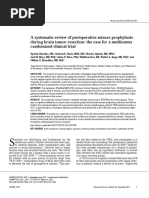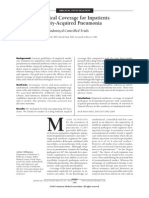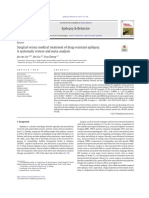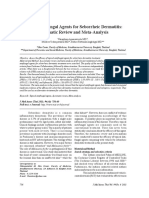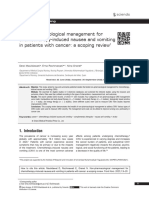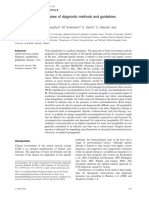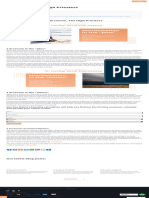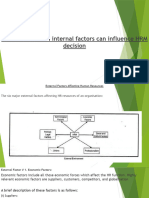HPV - 4
HPV - 4
Uploaded by
Apd. IDCopyright:
Available Formats
HPV - 4
HPV - 4
Uploaded by
Apd. IDOriginal Description:
Original Title
Copyright
Available Formats
Share this document
Did you find this document useful?
Is this content inappropriate?
Copyright:
Available Formats
HPV - 4
HPV - 4
Uploaded by
Apd. IDCopyright:
Available Formats
Review
A systematic review evaluating the efficacy and safety of
a combination of ablative treatment and self administered
treatment versus ablative treatment alone for external
anogenital warts
Cheng Feng1, MD, Wei Li2, MD, PhD, Xiaojun Wang1, MD, Hailin Zhang1, MD,
Loubin Si1, MD, Zhixiong Chen1, MD and Ming Bai1, MD
1
Department of Plastic Surgery, Peking Abstract
Union Medical College Hospital, Chinese Background External anogenital warts are proliferative lesions. Till now, there is no
Academy of Medical Sciences & Peking
consensus on the standard treatment of external anogenital warts. The combination of
Union Medical College, Beijing, China, and
2
Cancer Center, Beijing Ditan Hospital,
ablative therapy and self-administered treatment has been reported to achieve sustained
Capital Medical University, Beijing, China complete clearance than ablative therapy. The aim of this review was to compare the
efficacy on achieving complete clearance of warts between the combination of ablative
Correspondence therapy with self-administered therapy and ablative therapy alone.
Ming Bai, MD
Methods We conducted a systematic review to evaluate the efficacy and safety of the
Peking Union Medical College Hospital
(Dongdan campus)
combination of ablative therapy and self-administered treatment for external anogenital
No.1 Shuaifuyuan Wangfujing Dongcheng warts. The Cochrane Central Register of Controlled Trials, Medline, Embase and Science
District Citation Index Expanded, China National Knowledge Infrastructure and Wanfang were
Beijing 100730 searched.
China
Results Of 1138 initially identified publications, 37 studies in English and Chinese were
E-mail: majaca@sina.com
included. The combination of ablative therapy and self-administered treatment therapy
showed significantly high complete clearance rates at 4, 8, 12, or 24 weeks after
Conflict of interest: None.
treatment compared to ablative therapy alone. In a subgroup analysis based on the treatment
Funding source: None. duration of imiquimod cream therapy, 4 and 8 weeks of imiquimod 5% cream plus CO2 laser
produced similar efficacy on clearance. The combination therapy is tolerable for patients.
Conclusions In conclusion, this review provided evidence to support the use of the
doi: 10.1111/ijd.14863 combination of ablative therapy and self-administered treatment for external anogenital
warts to maintain sustained clearance.
mainly include ablative therapy (e.g. laser ablation, cryoablation,
Introduction
microwave ablation, and electrosurgery) and non-ablative therapy
External anogenital warts (EAGWs) are proliferative lesions, (e.g. trichloroacetic acid).4 The self-administered treatments
generally caused by “low risk” human papillomavirus (HPV) mainly include imiquimod, podophyllotoxin, and polyphenon E. The
types 6 and 11.1 The overall incidence of EAGWs has been ablative therapy can lead to rapid clinical efficacy on visible lesions,
reported as ranging from 160 to 289 per 100,000 individuals, however, it has poor efficacy on maintaining complete clearance
with a median of 194.5 per 100,000.2 EAGWs, including both and carries high risk of recurrence.5 The self-administered treat-
external genital warts and external perianal warts, usually occur ments can be helpful for achieving sustained clearance and reduc-
on the coronal sulcus, frenulum, penis, scrotum, vulva, clitoris, ing recurrence but usually need a long time.6,7 Therefore, the
urethral meatus, introitus, perianal areas, and perineal areas. combination of ablative treatment and adjuvant self-administered
The presence of EAGWs would bring about negative impact on treatment is appealing. The rationale for the combination therapy
quality of life of patients, such as the impact on sexuality and on EAGWs is that adjuvant self-administered treatment can
feelings of shame, guilt, and anxiety.3 achieve local control on subclinical warts based on the destruction
Until now, there is no consensus on the standard treatment of of all visible warts caused by ablative therapy.8
EAGWs. Generally speaking, the common treatments can be There are some systematic reviews on the treatment of
divided into two categories: provider-administered treatment and EAGWs that have been published, and most of them focused
self-administered treatment. The provider-administered treatments on monotherapy on warts, such as intralesional 1
ª 2020 the International Society of Dermatology International Journal of Dermatology 2020
2 Review Combination treatment for external anogenital warts Feng et al.
immunotherapy,9 imiquimod,10 cantharidin treatment,11 laser Data extraction and management
therapy and photodynamic therapies,12 and combined thera- Two authors (Cheng Feng and Wei Li) independently extracted
pies.3,13 However, till now, it is hard to identify the standard the data from all included articles. Disagreements were
treatment strategy with satisfying efficacy. resolved by discussion. Consulting the third review author or
Recently, some studies have reported that the combination writing correspondence to the original investigators was done
treatment strategy can generate a more favorable clearance when necessary. Basic study characteristics (the first author,
rate than ablative treatment alone for EAGWs.7,8 However, year of publication, sample size), demographic data of patients,
there is still lack of clear and compelling evidence to prove bet- information of treated warts, information of treatment (e.g.
ter efficacy of the combination treatment. Therefore, we con- concentration, duration, dosage, and frequency), and outcomes
ducted a well-designed review with the intention to provide the were recorded.
best level of evidence for the role of the combination of ablative Intention-to-treat (ITT) analysis was performed whenever
treatment and self-administered treatment for treating EAGWs. possible for all included studies. ITT analysis was defined as
people being analyzed in each group to which they were
allocated at randomization, irrespective of whether they finished
Methods
treatment or were lost to follow-up. All missing data were
A systematic review was conducted evaluating the efficacy and analyzed as treatment failure for all outcomes.13
safety of the combination of ablative treatment with self-
administered treatment for EAGWs. We followed the Assessment of risk of bias
methodology of the ‘Cochrane Handbook’ for Systematic Two review authors (Hailin Zhang and Loubin Si) independently
Reviews of Interventions.14 This review was registered on assessed the risk of bias of each included trial following the
PROSPERO (no. CRD42018114807). instructions given in the Cochrane Handbook for Systematic
Reviews of Interventions and methodological studies.14 The risk
Electronic searches of bias of all domains were classified as high, unclear, or low
We performed electronic searches in the following databases: risk of bias. Disagreements were resolved by discussion.
The Cochrane Central Register of Controlled Trials (CENTRAL), Consulting the third review author was done when necessary.
Medline (via PubMed), Embase, and Science Citation Index
Expanded (Web of Science) on the August 7th and 8th, 2018. Data-analysis
We also identified relevant randomized clinical trials (RCTs) in We explored heterogeneity by the Chi2 test with significance set
two of the most prevalent Chinese databases, which were at P < 0.10. In addition, we accessed the quantity of
China National Knowledge Infrastructure (CNKI) and Wanfang. heterogeneity by using the I2 statistic.
The search strategies are shown in the Supplementary file. We performed meta-analysis whenever it was possible.
Otherwise, we provided narrative summary of the results. We
Selection of studies analyzed data using the software Review Manager 5.3.15 The
Two review authors (Cheng Feng and Xiaojun Wang) treatment efficacy was analyzed by using a random-effects
independently asked for inclusion of all the titles and abstracts model.
of records retrieved from the search. Selected studies were
further screened by retrieving full texts. All RCTs which
Results
compared the efficacy of the combination of ablative treatment
(laser therapy, cryotherapy, microwave ablation, or Results of the search
electrocautery) with self-administered treatment (imiquimod, We retrieved a total of 1138 references and screened 760
podophyllotoxin, or polyphenon E) vs. ablative treatment alone records after excluding duplicates. Full text of 93 articles was
for EAGWs were included. Non-RCTs, reviews, case series, obtained. Finally, 37 RCTs7-8,16-50 were included in this review.
letters to the editor, and non-human studies were excluded. The The search process is shown in Figure 1. Details of all included
language was limited to English and Chinese. Disagreements RCTs are shown in Table S1.
were resolved by discussion. Consulting the third review author The 37 RCTs included 3476 participants. All 37 RCTs
was done when necessary. focused on the treatment of EAGWs. The sample size of stud-
ies ranged from 42 to 240 patients. This review focused on the
Outcomes endpoints of CCR and adverse events. In the study by Schofer
The primary outcomes were complete clearance rates (CCR) at et al.,18 the ablative therapy was defined as electrocautery, liq-
4, 8, 12, and 24 weeks after treatment. Complete clearance uid nitrogen, laser therapy, or surgery. However, 69% of
was defined as disappearance of all warts, including baseline patients in the mono-ablative therapy group and 63% of patients
warts, any recurrent warts, and any new warts during follow-up. in the combined therapy group were treated by electrocautery.
The secondary outcome was adverse events. Therefore, we roughly included the results of this study in the
International Journal of Dermatology 2020 ª 2020 the International Society of Dermatology
Feng et al. Combination treatment for external anogenital warts Review 3
Figure 1 Flow diagram of studies included
in the review
analysis of the comparison of electrocautery plus imiquimod 5% contribute data to every outcome of interest. For each available
cream vs. electrocautery alone. outcome, we performed subgroup analysis whenever possible.
Only one RCT26 examined the CCR at 4 and 8 weeks after
Risk of bias the treatment. The combination of CO2 laser and imiquimod 5%
The results of assessment of risk of bias for each study are cream treatment generated similar treatment efficacy on clear-
shown in Fig. S1. For seven comparisons in the present review, ance of EAGWs at both 4 and 8 weeks after treatment
the risk of bias of included RCTs were shown in Table 1. Most (P > 0.05).
of included studies did not describe the methods of random Twelve RCTs24,28,31-32,35,39,41,43-44,48,49 reported the CCR at
sequence generation, details of allocation concealment and 12 weeks after the treatment. The CO2 plus imiquimod 5%
blinding, and thus have unclear risk of bias. cream therapy was associated with a significantly higher CCR,
compared to CO2 laser alone (RR 1.53, 95% CI 1.38–1.71,
Efficacy I2 = 46%, Table 2, Fig. S2). We performed subgroup analysis
according to the duration of imiquimod 5% cream treatment
CO2 laser + imiquimod 5% cream vs. CO2 laser (Table 2, Fig. S3). The results showed that the CO2 laser plus
Twenty-six RCTs16-17,19,22-28,31-35,39,41-50 compared the efficacy imiquimod 5% cream therapy with the duration of 4 weeks (RR
of CO2 laser plus imiquimod 5% cream treatment with CO2 1.51, 95% CI 1.22–1.87, I2 = 28%), 8 weeks (RR 1.50, 95% CI
laser alone for treating EAGWs. However, they did not 1.36–1.65, I2 = 0%), and 12 weeks (RR 2.29, 95% CI 0.87–
ª 2020 the International Society of Dermatology International Journal of Dermatology 2020
4 Review Combination treatment for external anogenital warts Feng et al.
Table 1 Risk of bias of included studies in seven therapy was significantly higher than that of MWA therapy alone
comparisons (RR 2.20, 95% CI 1.26–3.83, I2 = 73%, Table 1, Fig. S6).
Number Number of Number Cryoablation + imiquimod 5% cream vs. cryoablation
of included of Only two RCTs21,30 assessed the efficacy and safety of cryoab-
included studies included
lation plus imiquimod 5% cream treatment and cryoablation
studies with studies
with low unclear with high therapy for EAGWs. In these included studies, Chen et al.30
risk of risk of risk of concluded that the combination therapy had similar efficacy at
Comparisons bias bias bias 4 weeks (P = 0.051) and better efficacy at 8 weeks (P = 0.003)
on complete clearance of EAGWs. Ding et al.21 observed that
CO2 laser + imiquimod 5% 0 26 0
CCR at 24 weeks after the combined treatment was signifi-
cream vs. CO2 laser
Electrocautery + imiquimod 5% 0 2 1 cantly higher than that after cryoablation monotherapy
cream vs. electrocautery (P < 0.001).
MWA + imiquimod 5% cream 0 3 0
vs. MWA
Cryoablation + podophyllotoxin cream vs. cryoablation
Cryoablation + imiquimod 5% 0 2 0
Only one RCT29 was included. According to the authors, there
cream vs. cryoablation
Cryoablation + podophyllotoxin 0 0 1 was no statistical difference on CCR at 4 weeks (P = 0.141),
cream vs. cryoablation 8 weeks (P = 0.463), and 12 weeks (P = 0.672) after treat-
Cryoablation + sinecatechins 0 0 1 ment.
15% vs. cryoablation
Cryoablation + sinecatechins 15% vs. cryoablation
MWA, microwave ablation.
One RCT8 reported that cryoablation plus sinecatechins 15%
have similar CCR at 8 weeks with that after cryoablation
6.00, I2 = 89%) generated similar efficacy (P = 0.69) on achiev- (P = 0.694).
ing complete clearance of EAGWs at 12 weeks after treatment.
The results of CCR at 24 weeks after treatment correspond Adverse events
to the meta-analysis of six RCTs16,22,33,46-47,50. There was sig- For adverse events, data extracted from original articles did not
nificantly higher CCR at 24 weeks after the combination of CO2 allow us to perform meta-analysis. So, here, we only made a
laser with imiquimod 5% cream treatment than CO2 laser alone narrative summary of adverse events reported in all 37 included
(RR 1.90, 95% CI 1.42–2.53, I2 = 73%, Table 2, Fig. S4). The studies. The adverse events in both combined treatment group
results of subgroup analysis of duration of imiquimod 5% cream and ablative treatment group mainly included mild or moderate
treatment are shown in Table 2 and Figure S5. There was no erythema, edema, burning, itching, erosion, pain, and ulcera-
significant difference (P = 0.53) between the efficacy of imiqui- tion. No significant difference of rates of adverse events was
mod 5% cream treatment of 8 weeks (RR 2.49, 95% CI 1.71– reported between the combination treatment group and ablative
3.61, I2 = 0%) and 12 weeks (RR 2.06, 95% CI 1.30–3.26, treatment group. Most adverse events occurred 2–4 weeks after
I2 = 66%) on complete clearance of EAGWs. the initiation of treatment. For prognosis, most adverse events
were self-limited and would resolve spontaneously. Sometimes,
Electrocautery + imiquimod 5% cream vs. electrocautery symptomatic treatment and dose reduction of drug can be
One RCT18 compared the efficacy and safety of electrocautery needed. Additionally, discontinuation of drug and blinded medi-
plus imiquimod 5% cream therapy with electrocautery therapy cation were reported in some articles, and details are shown in
and reported CCR at 12 weeks after treatment. The results Table 3.
showed that treatment efficacy of two different treatments was
similar (P = 0.171).
Discussion
Two RCTs38,40 reported CCR at 24 weeks after treatment.
The combined therapy generated significantly high rates of This systematic review indicated that the combination of abla-
complete clearance (RR 1.62, 95% CI 1.33–1.97, I2 = 0%, tive therapy and self-administered therapy had better efficacy
Table 2, Fig. S6) on EAGWs, compared to ablative therapy on achieving complete clearance of EAGWs compared to abla-
alone. tive therapy alone. Both the combination treatment and ablative
monotherapy were tolerated. For the comparison of CO2
MWA + imiquimod 5% cream vs. MWA laser + imiquimod 5% cream vs. CO2 laser alone, 4 and
Three RCTs20,36,37 compared the efficacy between the MWA 8 weeks of imiquimod 5% cream treatment produced similar
plus imiquimod 5% cream treatment and MWA. The pooled clinical effect on maintaining complete clearance. For the com-
results showed that CCR at 24 weeks after the combination parison of cryoablation + podophyllotoxin cream vs. cryoablation
International Journal of Dermatology 2020 ª 2020 the International Society of Dermatology
Feng et al. Combination treatment for external anogenital warts Review 5
Table 2 Results of meta-analyses of CCR
Patients underwent Patients underwent Number of
Analyses combination treatment ablative treatment RR, 95% CI I2 studies
CO2 laser + imiquimod 5% cream vs. CO2 laser
1. CCR at 12 weeks after treatment 586 584 1.53, 1.38–1.71 46% 12
1.1 Subgroup analysis
1. 4 weeks of imiquimod 5% cream 90 90 1.51, 1.22–1.87 28% 2
2. 8 weeks of imiquimod 5% cream 368 367 1.50, 1.36–1.65 0% 7
75 74 2.29, 0.87–6.00 89% 2
2. CCR at 24 weeks after treatment 235 234 1.90,1.42–2.53 73% 6
2.1 Subgroup analysis
1. 8 weeks of imiquimod 5% cream 70 70 2.49, 1.71–3.61 0% 2
2. 12 weeks of imiquimod 5% cream 82 82 2.06, 1.30–3.26 66% 2
Electrocautery + imiquimod 5% cream vs. electrocautery
CCR at 24 weeks after treatment 90 88 1.62,1.33–1.97 0% 2
MWA + imiquimod 5% cream vs. MWA
CCR at 24 weeks after treatment 119 115 2.20, 1.26–3.83 73% 3
CCR, compete clearance rate, 95% CI, 95% confidence interval.
Table 3 Discontinuation of drug and blinded medication reported in included articles
Treatment strategy Study Events Related treatment group Patients
CO2 laser + imiquimod 5% He Xiaoyan 2008 Drug discontinuation CO2 laser + imiquimod 5% cream group 9 (9/57, 16%)
cream vs. CO2 laser Xiang Qing 2008 Drug discontinuation CO2 laser + imiquimod 5% cream group 7 (7/29, 24%)
Zhang Chunmei 2008 Drug discontinuation CO2 laser + imiquimod 5% cream group NA
Huang Fuxiang 2010 Drug discontinuation CO2 laser + imiquimod 5% cream group 6 (6/35, 17%)
Wu Hanguang 2010 Drug discontinuation CO2 laser + imiquimod 5% cream group 3 (3/48, 6%)
Li Jianming 2018 Drug discontinuation CO2 laser + imiquimod 5% cream group NA
Electrocautery + imiquimod 5% Helmut Scho€fer 2006 Drug discontinuation Electrocautery + imiquimod 5% cream 4 (4/103, 4%)
cream vs. electrocautery group
Xu Ping 2011 Drug discontinuation Electrocautery + imiquimod 5% cream NA
group
MWA + imiquimod 5% cream vs. Shen Hui 2011 Drug discontinuation MWA + imiquimod 5% cream group NA
MWA
Cryoablation + imiquimod 5% Chen Heng 2009 Drug discontinuation Cryoablation + imiquimod 5% cream NA
cream vs. cryoablation group
Cryoablation + podophyllotoxin R J C Gilson 2009 Stop of blinded Cryoablation + podophyllotoxin cream 13 (13/74,
cream vs. cryoablation medication group 18%)
R J C Gilson 2009 Stop of blinded Cryoablation group 4 (4/75, 5%)
medication
MWA, microwave ablation; NA, not available.
and cryoablation + sinecatechins 15% vs. cryoablation, the lesion, enhance immunological function and maintain efficacy.
results showed no significant difference on clearance rate. How- Therefore, sustained complete clearance would be promised in
ever, for these two comparisons, only one RCT was included, the combination treatment strategy.
which can lead to a high level of bias on efficacy assessment. There are several limitations in this review. The risk of bias
The rationale of the combination of ablative therapy and self- of most of the included studies in this review is unclear,
administered treatment can be explained as follows: the ablative because they provided limited information about random
therapy is a destructive therapy that can achieve fast efficacy sequence generation, allocation concealment, and blinding.
on warts, with high recurrence rate, because the ablative ther- Meta-analysis and related subgroup analyses of some compar-
apy just removes the visible warts without eliminating underlying isons were not possible because of the relatively small number
HPV infection. The self-administered treatment can control sub- of included RCTs. Some studies did not provide detailed basic
clinical warts, which are likely to present near the primary characteristics of enrolled patients, and we were not sure about
ª 2020 the International Society of Dermatology International Journal of Dermatology 2020
6 Review Combination treatment for external anogenital warts Feng et al.
some important clinical information. For some specific subsets sequentially with cryotherapy in the treatment of external genital
of the population, such as immunocompromised patients and warts. J Drugs Dermatol 2014; 13: 1400–1405.
9 Salman S, Ahmed MS, Ibrahim AM, et al. Intralesional
immunocompetent patients, the clinical efficacy would be differ-
immunotherapy for the treatment of warts: A network meta-
ent, and it is appropriate to report the efficacy for different sub- analysis. J Am Acad Dermatol 2019; 80: 922–930.e4.
sets of population separately. Another limit of our review is that 10 Grillo-Ardila CF, Angel-Muller E, Salazar-Diaz LC, et al.
most of included studies enrolled both untreated EAGWs and Imiquimod for anogenital warts in non-immunocompromised
recurrent EAGWs. However, the treatment on recurrent EAGWs adults. Cochrane Database Syst Rev 2014; 11: CD010389.
11 Vakharia PP, Chopra R, Silverberg NB, et al. Efficacy and
would be more difficult than primary EAGWs.
safety of topical cantharidin treatment for Molluscum
There are some implications for future researches. Clear Contagiosum and Warts: a systematic review. Am J Clin
statements of randomization method, blinding, and allocation Dermatol 2018; 19: 791–803.
method are highly recommended. Future research studies 12 Maranda EL, Lim VM, Nguyen AH, et al. Laser and light therapy
should display detailed basic characteristics of patients. Further for facial warts: a systematic review. J Eur Acad Dermatol
Venereol 2016; 30: 1700–1707.
research is recommended to focus on specific population (e.g.
13 Thurgar E, Barton S, Karner C, et al. Clinical effectiveness and
immunocompromised patients and immunocompetent patients; cost-effectiveness of interventions for the treatment of
female or male) and specific warts (e.g. primary warts or recur- anogenital warts: systematic review and economic evaluation.
rent warts). Health Technol Assess 2016; 20: v–vi, 1–486.
14 Higgins JPT, Green S. Cochrane Handbook for Systematic
Reviews of Interventions. Version 5.1.0. The Cochrane
Conclusions Collaboration, 2011 http://handbook-5-1.cochrane.org
15 Review Manager (RevMan), Version 5.3., Copenhagen,
In conclusion, the results of this review provided evidence to Denmark: The Nordic Cochrane Centre, The Cochrane
support the use of the combination of ablative therapy and self- Collaboration, 2014.
administered treatment for EAGWs. The combination therapy is 16 Ju W, Zhongfang L, Xibao Z. 5% imiquimod for recurrent
condloma acuminatum. Southern China J Dermatology 2005;
tolerable for patients with EAGWs. In the future, more high-
8: 31–32.
quality RCTs are needed to conduct conclusions with a high 17 Dongyan H, Lei C, Ming L. Preventing the recurrence of
level of evidence and provide guidance for clinical treatment. condyloma with different treatment courses of imiquimod cream.
Chin J Dermatol 2006; 39: 258–259.
18 Schofer H, Van Ophoven A, Henke U, et al. Randomized,
References comparative trial on the sustained efficacy of topical imiquimod
5% cream versus conventional ablative methods in external
1 Aubin F, Pretet JL, Jacquard AC, et al. Human papillomavirus
anogenital warts. Eur J Dermatol 2006; 16: 642–648.
genotype distribution in external acuminata condylomata: a
19 Yinhao M, Qingjiang Z, Yuxiang Z. Effect of imiquimod cream
Large French National Study (EDiTH IV). Clin Infect Dis 2008;
on preventing recurrence of condyloma acuminatum following
47: 610–5.
laser treatment. Chin J Clin Pharm 2006; 15: 27–28.
2 Patel H, Wagner M, Singhal P, et al. Systematic review of the
20 Zhihong L, Hechun S, Hongqi J. The combination of microwave
incidence and prevalence of genital warts. BMC Infect Dis 2013;
ablation with imiquimod 5% cream for 35 recurrent warts. China
13: 39.
J Lepr Skin Dis 2006; 22: 368.
3 Westfechtel L, Werner RN, Dressler C, et al. Adjuvant treatment
21 Mingkui D. The combination of cryoablation with imiquimod
of anogenital warts with systemic interferon: a systematic review
cream for 31 warts. J Chin Physician 2007; 9: 239.
and meta-analysis. Sex Transm Infect 2018; 94: 21–29.
22 Tong L. Clinical observation on treating condyloma acuminatum
4 Lacey CJ, Woodhall SC, Wikstrom A, et al. 2012 European
with CO2 laser and 5% imiquimod cream. Chin J Derm
guideline for the management of anogenital warts. J Eur Acad
Venereol 2007; 21: 576–577.
Dermatol Venereol 2013; 27: e263–e270.
23 Chunmei Z. Effect of BCG-PSN and imiquimod on preventing
5 Schofer H, Tatti S, Lynde CW, et al. Sinecatechins and
mutiple condyloma acuminatum. Chin J Derm Venereol 2008;
imiquimod as proactive sequential therapy of external genital
22: 484–485.
and perianal warts in adults. Int J STD AIDS 2017; 28: 1433–
24 Jianguang X, Nahui S. The combination of CO2 laser therapy
1443.
with imiquimod cream for condylona acuminatum. J Community
6 Yanofsky VR, Patel RV, Goldenberg G. Genital warts: a
Med 2008; 6: 17–18.
comprehensive review. J Clin Aesthet Dermatol 2012; 5: 25–36.
25 Pinhua Z. Disscussion of the treatment on the warts of 360
7 Puviani M, Galluzzo M, Talamonti M, et al. Efficacy of
female patients. Contemp Med 2008; 14: 52–53.
sinecatechins 10% as proactive sequential therapy of external
26 Qing X. Observe the curative effect of imiquimod to the patient
genital warts after laser CO2 ablative therapy: the PACT study
with CA and accompany with fundament disease. Chin J Derm
(post-ablation immunomodulator treatment of condylomata with
Venereol 2008; 22: 319–320.
sinecatechins): a randomized, masked outcome assessment,
27 Shuangshuang X. The clinical observation of treating recurrent
multicenter trial. Int J STD AIDS 2018; 30: 131–136.
perianal condyloma acuminatum with the combination of CO2
8 On SC, Linkner RV, Haddican M, et al. A single-blinded
laser with imiquimod cream. Chin J Derm Venereol 2008; 22:
randomized controlled study to assess the efficacy of twice daily
203.
application of sinecatechins 15% ointment when used
International Journal of Dermatology 2020 ª 2020 the International Society of Dermatology
Feng et al. Combination treatment for external anogenital warts Review 7
28 Xiaoyan H, Li W. Prophylactic use of imiquimod against post- 45 Yi F, Lixia C. Different treatments for condyloma acuminat in
surgical relapse of condyloma acuminatum. Chin Remedies Clin female. Chin Foreign Med Res 2013; 11: 47–48.
2008; 8: 614–616. 46 Chuanling Y, Desen Z. Efficacy observation of CO2 laser
29 Gilson RJ, Ross J, Maw R, et al. A multicentre, randomised, combined with Imiquimod cream in treatment of condyloma
double-blind, placebo controlled study of cryotherapy versus acuminatum. Med J Chin Peoples Health 2015; 27: 20. 3.
cryotherapy and podophyllotoxin cream as treatment for 47 Weimin L, Junchang R, Xianfeng L, et al. To analysis of the
external anogenital warts. Sex Transmitt Infect 2009; 85: 514– immunomodulatory effects and recurrence influence of
519. imiquimod cream in treatment of condyloma acuminatum. Int J
30 Heng C. The efficacy of the combination of cryoablation with Virol 2015; 22: 133–136.
imiquimod cream for perianal CA. Mod Prev Med 2009; 36: 48 Xiaorong X, Jiawen L, Junbin Z, et al. The comparison of
3192–3195. theapeutic effect between external use of 5% imiquimod cream
31 Yan X, Yu Z, Qingti T. The efficacy of the combination of CO2 and local injection ofa-1b interferon on perianal condyloma
laser with imiquimod cream for preventing recurrence of acuminatum. China Med Pharm 2015; 5: 63–65.
condyloma acuminata. China Med Abstract Dermatol 2009; 26: 49 Jun Y, Rui F, Futang P. Application of 5% imiquimod cream
6–7. combined with CO2 laser in the treatment of female condyloma
32 Fuxiang H, Tong Y, Weijun Z. The efficacy of the combination acuminatum. Chin J Hum Sex 2018; 27: 126–129.
of CO2 laser with imiquimod cream for warts. China Mod Med 50 Jianming L, Huaixiang W. The clinical efficacy of imiquimod 5%
2010; 17: 70–73. cream plus CO2 laser therapy for condyloma acuminatum. J
33 Hanguang W, Tianye W, Xiaorong X, et al. The clinical efficacy Med Theory Pract 2018; 31: 2131–2133.
of the combination of CO2 laser with imiquimod cream for CA. J
Diagn Ther Dermato-Venereol 2010; 17: 130–131.
34 Jinayong Z. Observation of topical application with 5% Supporting Information
imiquimod vream on condyloma acuminata replease prevention.
Chin J Derm Venereol 2010; 24: 587, 9. Additional Supporting Information may be found in the online
35 Yiquan Z. Clinical observation on combined treatment with version of this article:
carbon dioxode laser and imiquimod cream in 77 cases of Figure S1. Results of assessment of risk of bias for each
condyloma acuminatum. J Clin Exp Med 2010; 9: 979–980. included study
36 Dapeng D. The combination of microwave ablation with
Figure S2. Forest plot of comparison: CO2 laser + imiquimod
imiquimod 5% cream for warts. Harbin Med J. 2011; 31: 353.
37 Hui S, Yun M. The clinical observation of the combination of 5% 5% cream vs. CO2 laser; Outcome: complete clearance rate at
imiquimod cream with microwave ablation for CA. Chin J Lepr 12 weeks after treatment
Skin Dis 2011; 27: 588. Figure S3. Forest plot of comparison: CO2 laser + imiquimod
38 Ping X, Xiaoxing Z. Observation on therapeutic efficacy of 5% cream vs. CO2 laser; Outcome: Complete clearance rate at
condaloma acuminatum with 5% imiquimd cream combined with
12 weeks after treatment; Subgroups: The duration of
electroatery. Chin J Derm Venereol 2011; 25: 80–81.
39 Guoquan L. The clinical effect of CO2 laser in combination with imiquimod 5% cream treatment
the 5% imiquimod cream in treatment of perianal recurrent Figure S4. Forest plot of comparison: CO2 laser + imiquimod
genital warts. Chin Med Doctor 2012; 50: 26–27. 5% cream vs. CO2 laser; Outcome: complete clearance rate at
40 Minqi L, Xiaogeng H, Bingzhong C, et al. The efficacy of the 24 weeks after treatment
combination of electrocautery with imiquimod cream treatments
Figure S5. Forest plot of comparison: CO2 laser + imiquimod
for warts. Hainan Med J 2012; 23: 76–77.
41 Yuliang S, Juan X. The combination of CO2 laser with 5% 5% cream vs. CO2 laser; Outcome: Complete clearance rate at
imiquimod cream for condyloma acuminata. Jilin Med J 2012; 24 weeks after treatment; Subgroups: The duration of
33: 4783–4784. imiquimod 5% cream treatment
42 Kang Q. The observation of laser combined imiquimod creame Figure S6. Forest plot of comparison:
in treatment of genital warts. Med Inform 2013; 26: 253–254.
electrocautery + imiquimod 5% cream vs. electrocautery;
43 Qiang H. Imiquimod cream for preventing the recurrence of
warts after laser therapy. China Health Care Nutr 2013; 6: Outcome: complete clearance rate at 24 weeks after treatment
3185. Figure S7. Forest plot of comparison: MWA + imiquimod 5%
44 Yanli M, Liang W, Limin C, et al. Clinical observation on 120 cream vs. MWA; Outcome: complete clearance rate at
cases in treatment of condyloma acuminatum with imiquimod 24 weeks after treatment
and carbon dioxide laser. Progess Modern Biomed 2013; 13:
Table S1. Basic characteristics of included studies
882–884.
ª 2020 the International Society of Dermatology International Journal of Dermatology 2020
You might also like
- Efficacy of Acupuncture For Generalizes Anxity DisorderNo ratings yetEfficacy of Acupuncture For Generalizes Anxity Disorder10 pages
- Review Article: The Effectiveness and Safety of Acupuncture For Patients With Chronic Urticaria: A Systematic ReviewNo ratings yetReview Article: The Effectiveness and Safety of Acupuncture For Patients With Chronic Urticaria: A Systematic Review7 pages
- Journal of Clinical Medicine-7 April 2023 PublicationNo ratings yetJournal of Clinical Medicine-7 April 2023 Publication21 pages
- Chinese Herbal Medicine For Atopic Dermatitis: A Systematic ReviewNo ratings yetChinese Herbal Medicine For Atopic Dermatitis: A Systematic Review10 pages
- Azithromycin Vs Penicillin G Benzathine For Early SyphilisNo ratings yetAzithromycin Vs Penicillin G Benzathine For Early Syphilis7 pages
- Eficácia e segurança da aplicação de pontos de acupuntura no tratamento da colite ulcerosaNo ratings yetEficácia e segurança da aplicação de pontos de acupuntura no tratamento da colite ulcerosa9 pages
- VORICONAZOL TDM GUIA JAPON JAPONESA 2022 LEER LEERNo ratings yetVORICONAZOL TDM GUIA JAPON JAPONESA 2022 LEER LEER20 pages
- Moxibustion For Cancer Care A SystematicNo ratings yetMoxibustion For Cancer Care A Systematic8 pages
- 2020 - Immunotherapy Targeting The PD-1 Pathway For Advanced Urothelial CarcinomaNo ratings yet2020 - Immunotherapy Targeting The PD-1 Pathway For Advanced Urothelial Carcinoma12 pages
- Management of Urinary Tract Infection in General Practice: A Cost-Effectiveness AnalysisNo ratings yetManagement of Urinary Tract Infection in General Practice: A Cost-Effectiveness Analysis6 pages
- Treatment of Acne Vulgaris: Clinical ReviewNo ratings yetTreatment of Acne Vulgaris: Clinical Review10 pages
- The Efficacy of 308-nm Excimer Laser/light (EL) and Topical Agent Combination Therapy Versus EL Monotherapy For Vitiligo: A Systematic Review and Meta-Analysis of Randomized Controlled Trials (RCTS)No ratings yetThe Efficacy of 308-nm Excimer Laser/light (EL) and Topical Agent Combination Therapy Versus EL Monotherapy For Vitiligo: A Systematic Review and Meta-Analysis of Randomized Controlled Trials (RCTS)9 pages
- Chinese Herbal Medicine For Atopic DermatitisNo ratings yetChinese Herbal Medicine For Atopic Dermatitis10 pages
- Comparative Efficacy of Anti-Epileptic Drugs For Neonatal Seizures: A Network Meta - AnalysisNo ratings yetComparative Efficacy of Anti-Epileptic Drugs For Neonatal Seizures: A Network Meta - Analysis8 pages
- Treatments For Infantile Hemangioma A Systematic ReviewNo ratings yetTreatments For Infantile Hemangioma A Systematic Review5 pages
- Original Articles: Surgical Infections Volume 13, Number 2, 2012 Mary Ann Liebert, Inc. DOI: 10.1089/sur.2011.058No ratings yetOriginal Articles: Surgical Infections Volume 13, Number 2, 2012 Mary Ann Liebert, Inc. DOI: 10.1089/sur.2011.05811 pages
- Surgical Versus Medical Treatment of Drug-Resistant Epilepsy: A Systematic Review and Meta-AnalysisNo ratings yetSurgical Versus Medical Treatment of Drug-Resistant Epilepsy: A Systematic Review and Meta-Analysis10 pages
- Relieving The Pruritus of Atopic Dermatitis: A Meta-AnalysisNo ratings yetRelieving The Pruritus of Atopic Dermatitis: A Meta-Analysis7 pages
- Treatment of Hyperprolactinemia: A Systematic Review and Meta-AnalysisNo ratings yetTreatment of Hyperprolactinemia: A Systematic Review and Meta-Analysis12 pages
- Efficacy and Safety of Dapsone Gel For Acne: A Systematic Review and Meta-AnalysisNo ratings yetEfficacy and Safety of Dapsone Gel For Acne: A Systematic Review and Meta-Analysis10 pages
- Using Acupuncture To Treat Depression A FeasibilitNo ratings yetUsing Acupuncture To Treat Depression A Feasibilit6 pages
- Laser Treatment For Onychomycosis A Systematic ReviewNo ratings yetLaser Treatment For Onychomycosis A Systematic Review10 pages
- Efficacy and Adverse Events of Oral Isotretinoin For Acne: A Systematic ReviewNo ratings yetEfficacy and Adverse Events of Oral Isotretinoin For Acne: A Systematic Review23 pages
- Non-Pharmacological Management For Chemotherapy-InNo ratings yetNon-Pharmacological Management For Chemotherapy-In12 pages
- Efficacy and safety of antiemetic regimens for highly emetogenic chemotherapy-induced nausea and vomiting: A systematic review and network meta-analysisNo ratings yetEfficacy and safety of antiemetic regimens for highly emetogenic chemotherapy-induced nausea and vomiting: A systematic review and network meta-analysis7 pages
- Atopic Dermatitis: New Perspectives on Managing a Chronic Inflammatory DiseaseFrom EverandAtopic Dermatitis: New Perspectives on Managing a Chronic Inflammatory Disease5/5 (1)
- Essentials of Clinical Trials: Clinical Trials Mastery Series, #1From EverandEssentials of Clinical Trials: Clinical Trials Mastery Series, #1No ratings yet
- Topic 1: The Diagram Below Shows The Production and Processing of Milk and Dairy ProductsNo ratings yetTopic 1: The Diagram Below Shows The Production and Processing of Milk and Dairy Products1 page
- 2 Arcanum, The High Priestess: Matrix DestinyNo ratings yet2 Arcanum, The High Priestess: Matrix Destiny1 page
- The20-Nitric Oxide-The Miracle-MoleculeNo ratings yetThe20-Nitric Oxide-The Miracle-Molecule23 pages
- Song A, Cola M, Plate S, Et Al. (2021) Natural Language Markers of Social Phenotype in Girls With AutismNo ratings yetSong A, Cola M, Plate S, Et Al. (2021) Natural Language Markers of Social Phenotype in Girls With Autism12 pages
- Bneo For Great Barangays Program Barangay Agenda For Governance and Development Barangay Pag-Ibig Sa Nayon District 1, Quezon City100% (5)Bneo For Great Barangays Program Barangay Agenda For Governance and Development Barangay Pag-Ibig Sa Nayon District 1, Quezon City3 pages
- Gaslighting Happens in Families. How To Spot and Stop It. - The Washington Post100% (2)Gaslighting Happens in Families. How To Spot and Stop It. - The Washington Post2 pages
- Adult ( 18 Years) Asthma Quick Reference Guide (Update Nov 2017)No ratings yetAdult ( 18 Years) Asthma Quick Reference Guide (Update Nov 2017)2 pages
- Limited Impact of Cannabidiol On Health-Related Quality of Life of People With Long-Term Controlled HIV: A Double-Blind, Randomized, Controlled TrialNo ratings yetLimited Impact of Cannabidiol On Health-Related Quality of Life of People With Long-Term Controlled HIV: A Double-Blind, Randomized, Controlled Trial9 pages
- Internal and External Factors Affects HR, Job Desription ND SpecializationNo ratings yetInternal and External Factors Affects HR, Job Desription ND Specialization28 pages
- Monitoring Evaluation Learning Accountability Throughout Project Program Life Cycle Habitat For HumanityNo ratings yetMonitoring Evaluation Learning Accountability Throughout Project Program Life Cycle Habitat For Humanity18 pages
- Efficacy of Acupuncture For Generalizes Anxity DisorderEfficacy of Acupuncture For Generalizes Anxity Disorder
- Review Article: The Effectiveness and Safety of Acupuncture For Patients With Chronic Urticaria: A Systematic ReviewReview Article: The Effectiveness and Safety of Acupuncture For Patients With Chronic Urticaria: A Systematic Review
- Journal of Clinical Medicine-7 April 2023 PublicationJournal of Clinical Medicine-7 April 2023 Publication
- Chinese Herbal Medicine For Atopic Dermatitis: A Systematic ReviewChinese Herbal Medicine For Atopic Dermatitis: A Systematic Review
- Azithromycin Vs Penicillin G Benzathine For Early SyphilisAzithromycin Vs Penicillin G Benzathine For Early Syphilis
- Eficácia e segurança da aplicação de pontos de acupuntura no tratamento da colite ulcerosaEficácia e segurança da aplicação de pontos de acupuntura no tratamento da colite ulcerosa
- VORICONAZOL TDM GUIA JAPON JAPONESA 2022 LEER LEERVORICONAZOL TDM GUIA JAPON JAPONESA 2022 LEER LEER
- 2020 - Immunotherapy Targeting The PD-1 Pathway For Advanced Urothelial Carcinoma2020 - Immunotherapy Targeting The PD-1 Pathway For Advanced Urothelial Carcinoma
- Management of Urinary Tract Infection in General Practice: A Cost-Effectiveness AnalysisManagement of Urinary Tract Infection in General Practice: A Cost-Effectiveness Analysis
- The Efficacy of 308-nm Excimer Laser/light (EL) and Topical Agent Combination Therapy Versus EL Monotherapy For Vitiligo: A Systematic Review and Meta-Analysis of Randomized Controlled Trials (RCTS)The Efficacy of 308-nm Excimer Laser/light (EL) and Topical Agent Combination Therapy Versus EL Monotherapy For Vitiligo: A Systematic Review and Meta-Analysis of Randomized Controlled Trials (RCTS)
- Comparative Efficacy of Anti-Epileptic Drugs For Neonatal Seizures: A Network Meta - AnalysisComparative Efficacy of Anti-Epileptic Drugs For Neonatal Seizures: A Network Meta - Analysis
- Treatments For Infantile Hemangioma A Systematic ReviewTreatments For Infantile Hemangioma A Systematic Review
- Original Articles: Surgical Infections Volume 13, Number 2, 2012 Mary Ann Liebert, Inc. DOI: 10.1089/sur.2011.058Original Articles: Surgical Infections Volume 13, Number 2, 2012 Mary Ann Liebert, Inc. DOI: 10.1089/sur.2011.058
- Surgical Versus Medical Treatment of Drug-Resistant Epilepsy: A Systematic Review and Meta-AnalysisSurgical Versus Medical Treatment of Drug-Resistant Epilepsy: A Systematic Review and Meta-Analysis
- Relieving The Pruritus of Atopic Dermatitis: A Meta-AnalysisRelieving The Pruritus of Atopic Dermatitis: A Meta-Analysis
- Treatment of Hyperprolactinemia: A Systematic Review and Meta-AnalysisTreatment of Hyperprolactinemia: A Systematic Review and Meta-Analysis
- Efficacy and Safety of Dapsone Gel For Acne: A Systematic Review and Meta-AnalysisEfficacy and Safety of Dapsone Gel For Acne: A Systematic Review and Meta-Analysis
- Using Acupuncture To Treat Depression A FeasibilitUsing Acupuncture To Treat Depression A Feasibilit
- Laser Treatment For Onychomycosis A Systematic ReviewLaser Treatment For Onychomycosis A Systematic Review
- Efficacy and Adverse Events of Oral Isotretinoin For Acne: A Systematic ReviewEfficacy and Adverse Events of Oral Isotretinoin For Acne: A Systematic Review
- Non-Pharmacological Management For Chemotherapy-InNon-Pharmacological Management For Chemotherapy-In
- Efficacy and safety of antiemetic regimens for highly emetogenic chemotherapy-induced nausea and vomiting: A systematic review and network meta-analysisEfficacy and safety of antiemetic regimens for highly emetogenic chemotherapy-induced nausea and vomiting: A systematic review and network meta-analysis
- Atopic Dermatitis: New Perspectives on Managing a Chronic Inflammatory DiseaseFrom EverandAtopic Dermatitis: New Perspectives on Managing a Chronic Inflammatory Disease
- Essentials of Clinical Trials: Clinical Trials Mastery Series, #1From EverandEssentials of Clinical Trials: Clinical Trials Mastery Series, #1
- Topic 1: The Diagram Below Shows The Production and Processing of Milk and Dairy ProductsTopic 1: The Diagram Below Shows The Production and Processing of Milk and Dairy Products
- Song A, Cola M, Plate S, Et Al. (2021) Natural Language Markers of Social Phenotype in Girls With AutismSong A, Cola M, Plate S, Et Al. (2021) Natural Language Markers of Social Phenotype in Girls With Autism
- Bneo For Great Barangays Program Barangay Agenda For Governance and Development Barangay Pag-Ibig Sa Nayon District 1, Quezon CityBneo For Great Barangays Program Barangay Agenda For Governance and Development Barangay Pag-Ibig Sa Nayon District 1, Quezon City
- Gaslighting Happens in Families. How To Spot and Stop It. - The Washington PostGaslighting Happens in Families. How To Spot and Stop It. - The Washington Post
- Adult ( 18 Years) Asthma Quick Reference Guide (Update Nov 2017)Adult ( 18 Years) Asthma Quick Reference Guide (Update Nov 2017)
- Limited Impact of Cannabidiol On Health-Related Quality of Life of People With Long-Term Controlled HIV: A Double-Blind, Randomized, Controlled TrialLimited Impact of Cannabidiol On Health-Related Quality of Life of People With Long-Term Controlled HIV: A Double-Blind, Randomized, Controlled Trial
- Internal and External Factors Affects HR, Job Desription ND SpecializationInternal and External Factors Affects HR, Job Desription ND Specialization
- Monitoring Evaluation Learning Accountability Throughout Project Program Life Cycle Habitat For HumanityMonitoring Evaluation Learning Accountability Throughout Project Program Life Cycle Habitat For Humanity








